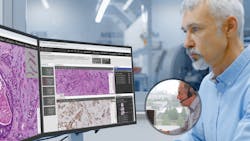Technological advances in healthcare have provided clinical laboratory operations the ability to deploy IT infrastructures that support better process and performance. The business focus of the lab has been more prevalent in the past 20 years —from being primarily specimen-focused diagnosis to data- and pathologist-driven, individualized medicine. When technology advances in ways that enable the business to continue to grow and evolve, it creates a perfect alignment of knowledge and technical capability to deliver meaningful, advanced outcomes for patients, while simultaneously delivering improved dividends.
No time has been better for determining which technology is the best one for any given lab and their various business models. Whether the facility is small and privately owned or a large, multi-national, multi-site reference lab, Laboratory Information Management Systems (LIS’s) can be on-site (turnkey), web-based or a hybrid. Patient data should be transparent to the LIS in its ability to access and incorporate the data. The LIS data should also be distinct in how it is able to follow the chain of command to receive and send information.
Laboratory-data management within a LIS
In every laboratory, the LIS is the source of truth. LIS is the central data hub for every test performed, every case, every visit and every patient seen throughout their history within the healthcare facility. This is a virtual gold mine of information. Most LIS’s today are able to store, sort and filter discreet data elements and fields. If your LIS cannot perform these tasks, then your LIS strategy should be revisited. Data management and its tremendous benefits are not possible without discreet data. A LIS should be able to interface seamlessly with all of your healthcare applications, bi-directionally. This enables a data stream to be read, reviewed and accessed in real-time.
Order history, patient information, clinical input and all relevant information (including comments) should be filtered into your lab’s LIS whether it is through EMRs, EHRs, HISs, other LIS’s or manually. A 360-degree view of the patient enables personalizing medicine during the testing and diagnostic process. All of the information that is analyzed and interpreted on that specific patient should then be stored in your lab’s database and sent back to the ordering facility or physician. This too, should be automatic with connectivity.
The real value of data management is its availability for study, analysis and interpretation as both unique and larger sets of data. This information is valuable both internally and externally to continue the treatment of sets, and subsets, of the patient population. The ability to search and find cases by diagnosis, demographic, geographic region, treatment plan, outcome, etc., is what identifies trends. Analysis of data as it relates to a specific set of patients or diagnosis provides the ability to identify best practices based upon specificity.
Point of care (POC) data management
There are many sources of external data that are extremely valuable during the diagnostic process. This information can reside in various other applications and documents. Having a process and the ability to digest this information is beneficial to the full view of the patient. There are a wide variety of applications that can provide this information automatically and electronically. There are various apps that capture health information and personal habits, including the record of weight, exercise, heartrate, BMI, blood pressure, blood glucose levels, etc. All of this information is germane to a 360-degree patient view and should be readily available for interfacing and management.
Think of the value of the above sets of data and how that dovetails more accurately into personalized medicine and its application to a specific patient. Once this information is included, we can begin to identify how these data classifications can be applied to larger data sets to further identify trends, understand demographic predispositions, disease identification and treatment plan outcomes.
This information can also come in the form of previous reports from other labs, additional providers on the continuum of care, reports from pharmacogenomics organizations and other external documents. With the technological capabilities that are available today, all of these documents can be imported into your lab’s data center and managed as data assets in conjunction with specific cases for the benefit of that patient—but also in the larger context of data management.
Laboratory management with external data
Optical character recognition (OCR) is the electronic or mechanical conversion of images of typed, handwritten or printed text into machine-encoded text. OCR software enables large amounts of data to be read, sorted, characterized and processed. Software programmers and Artificial Intelligence (AI) algorithms are putting an end to manual data entry using OCR, and are helping organizations to automate the management of both internal data and data from documents, rendering it instantly useful.
Do you consider laboratory information that is captured and processed on the instrumentation to be external data? It isn’t! This may surprise you, however, even though the information appears to be external to the software applications (LIS), it is internal to the laboratory and specific to the case being processed.
The information on instruments may be minute, though precise and invaluable to the pathologist’s diagnosis. Or, the information can include voluminous pages of data yet still very precise as it relates to the findings in the specimen. This type of data is invaluable to the diagnosis of a specific patient. Keep in mind patient data can also be captured and managed within a central data base while still being tied to a specific case.
Clinical laboratory value
The ability to manage patient data is valuable to the clinical laboratory for three reasons:
1. Speed, accuracy and efficiency
When a pathologist or physician has access to all of the information specific to a patient and their history in a single or easily accessible location, they are able to quickly and efficiently assess and diagnose that patient. When this information is automated, the risk of human error is significantly decreased. Therefore, automation ensures a much greater rate of accuracy and safety for the lab, pathologist and patient.
2. Market expansion
Vast sets of patient data are a valuable commodity. The lab has the ability to mine and generate their own information and statistics, such as developing assays and determining new test menus that would benefit their bottom line. There are also other facilities who are willing to purchase datasets. Many vendors, research institutes, clinical trial companies and payers are interested in purchasing information as it relates to de-identified sets of data. This information can be a great source of additional income for the lab. It is often very valuable to other organizations working in areas to advance the management and development of other healthcare technologies, services and diagnostics; thus expanding your lab’s market.
3. Business management
The information and data that is gathered and reportable in a laboratory is not just patient specific. Labs that are looking to better manage their businesses through operational efficiencies are able to use this information for a variety of reasons.
Labs can now track where their inventory is going and who is sending them business (ie: ordering physicians and/or other labs). For example, is your laboratory sending a disproportionate amount of supplies to a customer based upon the cases and case types that they are sending you?
Laboratories can also manage staff and productivity in terms of speed and accuracy, turnaround time at each process point, specimen tracking and corrections or amendments by cytotechnologists, pathologists, etc.
Labs are also able to monitor the quality of the specimens sent or gathered by location, loss rates, collections and other customer service metrics, and identify areas and people for retraining. In addition, labs can identify opportunities for new and existing customer engagement that would improve outbound marketing and sales activities.
In conclusion
Data management is a broad term. Discreet data has infinite possibilities. The types of data that are captured include everything from patient specific information to details of the ordering physician and facility. Information can be made more valuable by including treatment plans and outcomes— information not usually captured by the lab but available as part of the patient record. Operational information is captured by reviewing lab staff interactions and workflow to include legally defensible information such as who accessed a file, why and what changes they made.
Data management provides clinical laboratories a myriad of possibilities for use because there are vast amounts and types of information captured. All of this information is able to be analyzed and presented for better management of the patient, the laboratory diagnostic process and the operation of the laboratory business.






